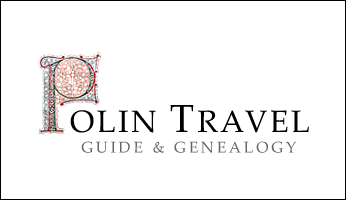1. THE FIRST DOCUMENTED ENCOUNTER
Ibrahim ibn Jacob - a Jewish Sephardic diplomat, traveller and merchant from Tortosa in the caliphate of Cordoba in Andalusia. He visited the Polish Kingdom lands in the mid 10th century, travelling along the main merchandising trail of slaves from Slavonic lands to Cordoba. Etymology of the word "slave" is a not a coincidence here. In his account from this travel, as it was reported by the latter Al-Bekri, Ibrahim ibn Jacob mentioned the kingdom ruled by Mieszko (the first Polish king) and the city of Cracow.
The first major Jewish emigration from Western Europe to Poland was caused by the First Crusade in 1098. Under Bolesław III (1102-1139), the Jews, encouraged by the tolerant regime of this ruler (one may say an early example of separation of state and religion), settled throughout Poland, developing their communities as far as Kiev and the Lithuanian territories. Bolesław III for his part embraced the utility of the Jews in the development of the country and its commercial potential. The Jews created the very tissue of economic relations and under Mieszko III there were "brakteaty" early medieval Polish coins minted with Hebrew letters.

Map of Jewish immigration to Poland in the middle ages.
2. THE LEGAL PROTECTION
On September 8th , 1264 in Kalisz the Duke of Greater Poland Bolesław the Pious issued a Charter of Jewish Liberties, known as the Statue of Kalisz.
Some of the chosen paragraphs below:
1. ... Should a Jew be taken to court, not only a Christian must testify against him, but also a Jew, in order for the case to be considered valid.
2. ... If any Christian shall sue a Jew, asserting that he has pawned securities with him, and the Jew denies it, then if the Christian refuses to accept the simple word of the Jew, the Jew by taking oath must be free of the Christian.
10. ... As punishment for killing a Jew, a suitable punishment and confiscation of property is necessary.
11. ... For striking a Jew, the usual punishment in the country shall apply.
13. ... Jews shall not pay for the transport of their dead.
17. ... Any Jew may freely and securely walk or ride without any let or hindrance in our realm. They shall pay customary tolls just as other Christians do, and nothing else.
22. ... If any of the Christians rashly and presumptuously jeers at their synagogues, such a Christian shall be required to pay and must pay to our palatine their guardian two talents of pepper as punishment.
30. ... No Christian may summon any Jew into the ecclesiastical court in any way whatsoever, or for whatever property or summons he be summoned, nor shall the Jew make answer before the judge in the ecclesiastical court, but the Jew shall appear before his palatine appointed for that term, and furthermore the aforesaid palatine, along with our governor for that term, shall be required to defend and protect that Jew, and prohibit his responding to the summons of the ecclesiastical court. No Christian is to accuse a Jew of blood libel.
This document was later renewed and guaranteed by most of the Polish Kings till the mid 16th century. Such privileged status offered to the Jews was unprecedented in Europe. It was one of the causes of mass immigration of Jews to Poland, or rather Polin, which gained the country a nickname of being "Paradisus Judaeorum".
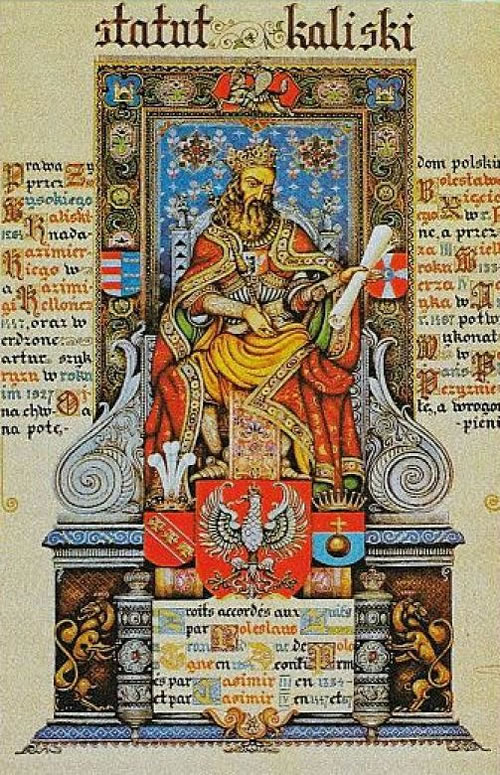
Picture of the first page of the Statute of Kalisz
illuminated by Arthur Szyk.
3. THE GOLDEN AGE OF 16th AND 17th CENTURY
Following the new influx of mostly Spanish Jews with the reign of Zygmunt Stary (1506-1548), who protected the Jews in his realm, Poland became a spiritual and cultural center of the World Jewry. King Zygmunt II August (1548-1572), mainly followed in the tolerant policy of his father and also granted autonomy to the Jews in the matter of communal administration and laid the foundation for the power of the autonomous Jewish community called Kahal. In 1581 under the King Stafan Batory Polish Jews are starting to lay foundations for its almost complete administrative autonomy with the creation of Waad Arba Arcot which was an institution of Jewish Parliament in Poland.
Jewish religious life, based on general tolerance in Poland thrived in many Polish communities. In 1503, the Polish monarchy appointed Rabbi Jacob Polak, the official Rabbi of Poland, marking the emergence of the Chief Rabbinate. By 1551, Jews were given permission to choose their own Chief Rabbi. The Chief Rabbinate held power over law and finance, appointing judges and other officials.
In 1518 Shalom Shakhna established a Talmudic seminary in Lublin which later became the Europe's famous - and in the 20th century - the world's famous Lublin Yeshiva. From 1567, according to the royal privilege Rosh of the Lublin, Yeshiva obtained the title of rector and right equal with those at other Polish Universities.
Moses Isserles (1520-1572), disciple of Shalom Shakhna, an eminent Talmudist of the 16th century and the author of the fundamental Halakhic Ashkenazi interpretation titled ha-Mapah established his yeshiva in Cracow. In addition to being a renowned Talmudic and legal scholar, Isserles was also learned in Kaballah, and studied history, astronomy, and philosophy. The Remuh Synagogue was built for him in 1557. Rema is the Hebrew acronym for his name.
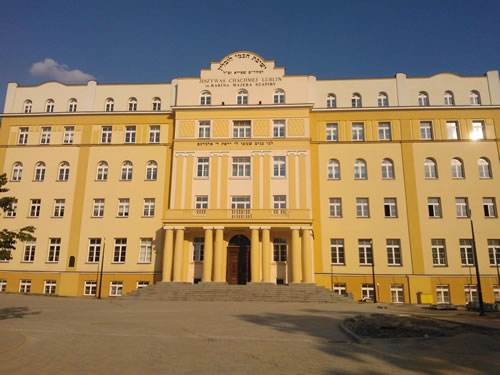
The contemporary picture of the Lublin Yeshiva building from 1930.
4. THE POLITICAL AND RELIGIOUS FERMENT
The mid XVII century marks the beginning of the end of the Polish-Lithuanian Empire.
Among major reasons of slow downfall which lasted some 150 years were: week central authorities and lack of institutions, lack of reforms and leadership, too large disparity between the haves and have-nots in the feudal system, too many external, political and internal social conflicts to follow and resolve, Polish gentry and nobility becoming loyal to external rulers.
The two events in particular shook the very foundations of the country and its social and political stability. At the same time they influenced seriously the condition of the Polish Jewish communities. Those were: the Bohdan Chmielnicki uprising of 1648, which pillaged the southern parts of the Kingdom and the Swedish Deluge of 1655, which brought almost complete destruction of the country's economic foundations.
This period brings massive destruction to the Jewish communities and seriously challenges their economic stability, rabbinical training and leadership. Progressing pauperization pushes Jewish population to live in smaller communities which produces the unique phenomena of a Shtetl. Linguistically the word "Shtetl" meant a little town. But a little town was by no means a Shtetl. Shtetl could mean only a little town in Eastern Europe, inhabited by Jews, either exclusively or in its majority with all the complicated tissue of their religious, social and political life.
The Talmudic learning became more and more limited and at the same time the religious debate became overly formalized, impractical and focusing on interpretative details more then on keeping the community coherent. At the same time unprecedented ferment of religious opinions was noticeable among the Jews of Poland, culminating in a series of false "Messianic" movements like Sabbataism or Frankism. Those mystical times brought the teachings of Israel ben Eliezer, known as the Baal Shem Tov, or BeShT, (1698-1760), which had a profound effect on the Jews of Eastern Europe and Poland in particular. His disciples taught and encouraged Hasidism, the new fervent brand of Judaism based on Kabbalah and devotion to life to religion only.
The environment of the Polish Commonwealth - wrote Professor Gershon Hundert in "Jews in Poland and Lithuania in 18th century" - profoundly affected Jews due to genuinely positive encounter with the Christian culture across the many cities and towns owned by the Polish aristocracy. There was no isolation. The Jewish dress resembled that of their Polish neighbour. "Reports of romances, of drinking together in taverns, and of intellectual conversations are quite abundant." Wealthy Jews had Polish noblemen at their table, and served meals on silver plates. By 1764, there were about 750,000 Jews in the Polish-Lithuanian Commonwealth.
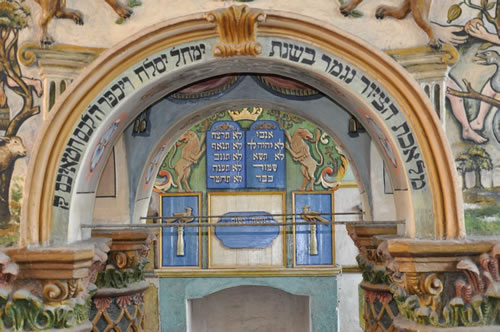
Picture of the Lancut synagogue.
5. THE GROWTH IN STRENGHT AND NUMBERS
The early 19th century brought new political realities to the Central Europe. Poland was no longer on the maps after being partitioned by its neighbors of Russia, Prussia and Austro-Hungarian Empire in 1772 ,1793 and 1795. The Polish Jews became the subjects of new rulers but largely maintained their Polish cultural and political identity which was exemplified by their participation in all three Polish national uprisings against the partition powers in 1794 under Tadeusz Kościuszko, in 1831 and 1863. Such political involvement was also exhibited during the Revolutionary Movement of 1905.
Most of the Polish Jews inhabited the territories annexed by Russia and their lives were seriously challenged by tsarist policy which alternated between harsh rules, and inducements meant to break the resistance to large-scale conversion. The Pale of Settlement and pogroms organized by the tsarist "Ohrana" security services killed or expelled many Jews of Russia's interior into the more peripheral former Polish territories. At the turn of 19th and 20th centuries the emigration of Polish Christians and Jews to America took massive scale. At the same time progressing industrialization and politicization of Polish Jews could be observed. In the former Polish south annexed to Austro-Hungarian Empire the region of Galicia was created to replace the geographical term of Minor Poland. Under the rule of emperor Franz Josef broad autonomy was granted to Galicia due to the political shrewdness and common sense of Galician intelligentsia. The Jewish Enlightenment, Haskalah, began to take hold in Poland during the 19th century, stressing secular ideas and values.
The heat of political debate caused by the growing political and security pressure produced a whole elaborate mosaic of Jewish political life in former Poland. Some of those political activities were important for Poland being reinstalled on the maps of Europe and regaining its independence in 1918.
In the 1930 Poland was inhabited by 3,3 millions of Jews who were making 10 percent of the total population. The Jews of Warsaw were making 33% of the city and average in other cities was around 25 to 30%. Polish Jews at that time were making most deeply rooted, most culturally, religiously, politically and socially sophisticated Jewish community ever in existence before. The literature of Julian Tuwim, Jan Brzechwa, Janusz Korczak or Antoni Słonimski is till this very day "imbued with the mother's milk" by every Polish child and a teenager.
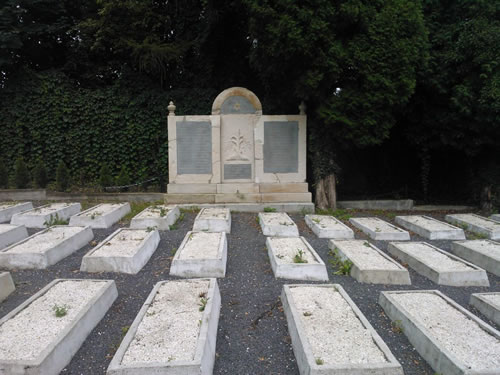
Picture of the Jewish military section from WW I at the Jewish cemetery in Bielsko-Biała.
6. THE HOLOCAUST
In late 1941 the Nazi Germany decided what is the next step in their anti-Jewish policy. This was also a time when they came across the technology of mass killing in gas chambers. Technology developed during experimental euthanasia program in the Third Reich - using carbon monoxide, experiments with gas vans in Chełmno where the exhaust fumes were directed into the back of a truck filled with people, finally experiments with cyclone B in Auschwitz I in September 1941. All efforts undertaken to make the crime more efficient and massive but also to make the perpetrators more anonymous and less mentally burdened within the process. The purpose was to make the crime sanitized from emotions and a factory alike process. With the massiveness of the crime there came a need to keep the major killing sites well hidden from the sight of the world's opinion and need for perfect logistics. Auschwitz-Birkenau was changed to be a destination for international transports of Jews using its concentration camp history as a cover up for the new mass extermination function. In order not to block the technical capacity of gas chambers of Birkenau with Polish Jews, the German Nazis took a decision to open 4 major, extermination camps in Chełmno, Bełżec, Treblinka and Sobibór.
They were to be built in scarcely populated territories, well hidden in the forests, far from Western Europe, built to operate temporarily just to kill as many Jews as possible from particular well planned territory and designed to be taken apart completely after the task is accomplished.
Chełmno - 18 months of operation -150.000 people killed.
Belżec - 12 months of operation - 500.000 people killed.
Sobibór - 19 months of operation - 220.000 people killed
Treblinka - 12 months of operation - 900.000 people killed.
Today no physicality of those camps exists. The German-Nazi crime was not only about killing the Polish Jews but it was also about eradicating the memory about their ever existence, the memory of their heritage and culture and obliterating a way in which they were killed. The crime was to be perfect and the cover up took a tremendous effort causing the current broadly shared lack of awareness of who the Polish Jews were and where they were killed.
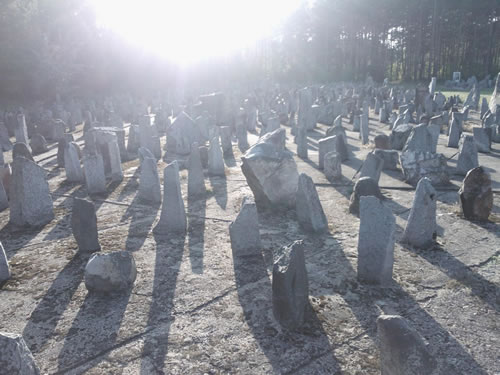
Picture of the monument at Treblinka.
7. LONG REBIRTH
In the postwar vehemently changing reality in Poland the estimated 250.000 of Polish Jews who survived the Holocaust experienced growing anti-Semitism, political instability and lack of security. Those prompted large waves of emigration between 1945-1948 and 1957-1959. The communist regime in Poland was instrumentally using anti-Semitism in internal country politics which led to the wave of anti-Zionist/anti-Semitic events in 1968. The negatively burdened image of Poland as a country in the collective memories of Jews in the world can be anchored in this short time period just after the war when the Jewish refugees returning to Poland were betrayed and denied access to their homelands. At this time the atrocities were not perpetrated by some external authority of the Third Reich invading Poland, but by the very Polish neighbors with whom the last centuries of common country and culture had been shared. The waves of emigration and the isolation by Iron Curtain has pushed the Poles and Polish Jews into the two separate , independently constructed communities of memory about the shared and troubled past. Those few that remained carried through the tradition of Judaism within communist regime harsh controlled institutions. The 45 years of communism in certain level put the Polish -Jewish relations into a social and historical "freezer" and suspension in thick air of mutual stereotypes and blaming without a possible platform of meeting again.
After 1989 the democratic Poland from the very beginning started to look for and embrace its multiethnic past. Israel was among the first visited destinations of president Lech Wałęsa in 1991, after the official diplomatic relations were reestablished in 1990.
Poland was looking for its past but also more and more often Poland was looked for by the descendants of Polish Jews in the world.
Since the late 90's the concept of the construction of The POLIN - Museum of the History of Polish Jew was considered.
In 2013 in Warsaw the impressive building of the Museum was inaugurated to start its long awaited service as an educational bridge gapping the void of Polish-Jewish relations non-existence. On October 28th , 2014 the eight core exhibition galleries were inaugurated to strengthen the museum's message and promote the heritage of Polish Jews and more complete understanding of ten centuries of their history.
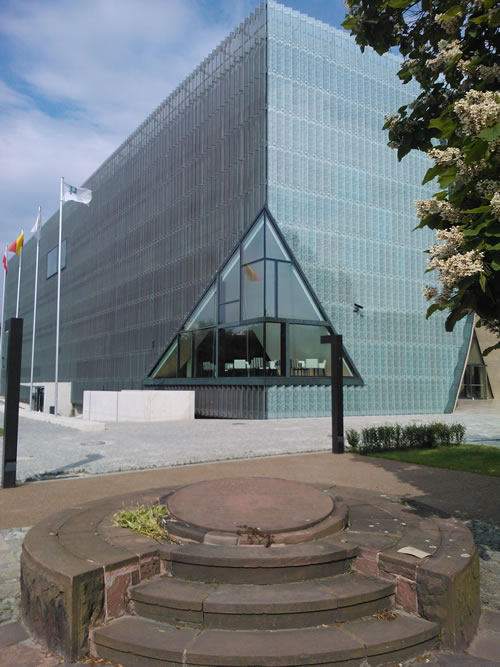
Picture of the building of The POLIN - Museum of the History of Polish Jews in Warsaw.
First monument to the Warsaw Ghetto Uprising erected in 1946 in the foreground.
